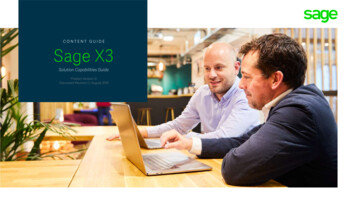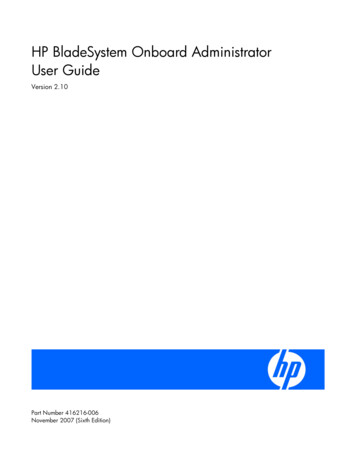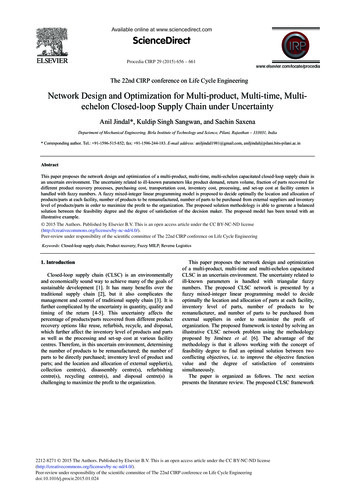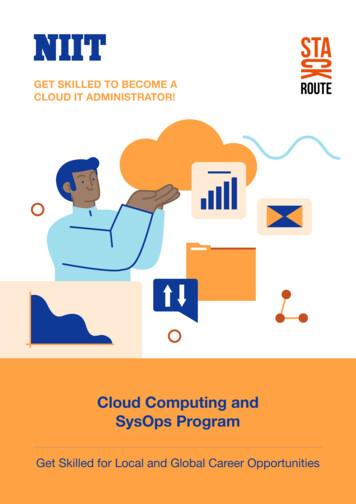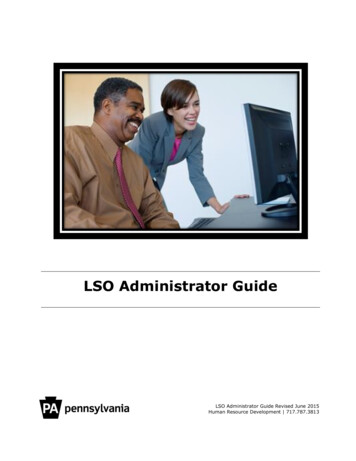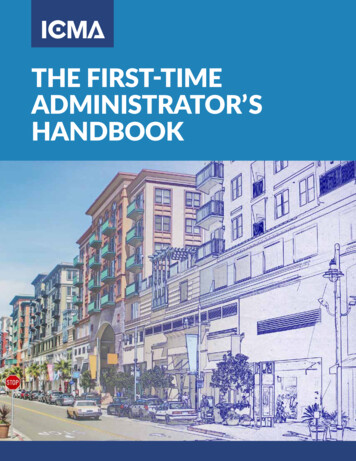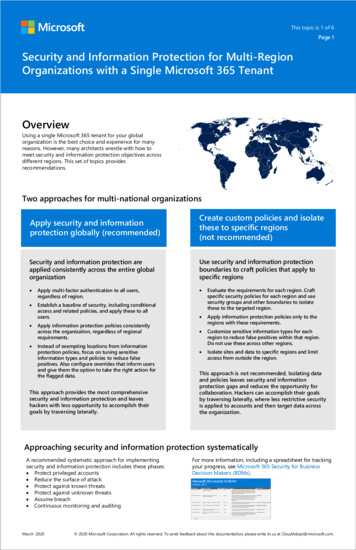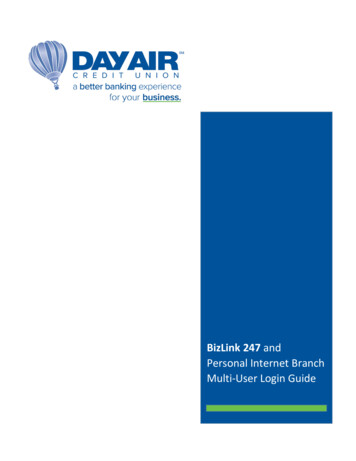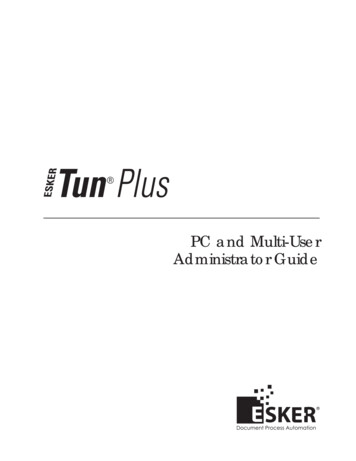
Transcription
PC and Multi-UserAdministrator Guide
Tun Plus 2009Issued May 2008Copyright 1989-2008 Esker S.A. All rights reserved. 1998-2002 The OpenSSL Project; 1994-2003 Sun Microsystems, Inc.; 1996 Wolfgang Platzer (wplatzer@iaik.tugraz.ac.at); 1995-1998 Eric Young (eay@cryptsoft.com). All rights reserved. Tun contains components which are derivedin part from OpenSSH software. See the copyright.txt file on the Tun CD for additional copyright notices, conditions of useand disclaimers. Use and duplicate only in accordance with the terms of the Software License Agreement - Tun Products.North and South American distributions of this manual are printed in the U.S.A. All other distributions are printed in France.Information in this document is subject to change without notice. No part of this document may be reproduced or transmittedin any form or by any means without the prior written consent of Esker S.A.Esker S.A., 10 rue des Émeraudes, 69006 Lyon, FranceTel: 33 (0)4.72.83.46.46 Fax: 33 (0)4.72.83.46.40 info@esker.fr www.esker.frEsker, Inc., 1212 Deming Way, Suite 350, Madison, WI 53717 USATel: 1.608.828.6000 Fax: 1.608.828.6001 info@esker.com www.esker.comEsker Australia Pty Ltd. (Lane Cove - NSW) Tel: 61 (0)2 8596 5100 info@esker.com.au www.esker.com.auEsker GmbH (München) Tel: 49 (0) 89 700 887 0 info@esker.de www.esker.deEsker Italia SRL (Milano) Tel: 39 02 57 77 39 1 info@esker.it www.esker.itEsker Ibérica, S.L. (Madrid) Tel: 34 91 552 9265 info@esker.es www.esker.esEsker UK Ltd. (Derby) Tel: 44 1332 54 8181 info@esker.co.uk www.esker.co.ukEsker, the Esker logo, Esker Pro, Extending the Reach of Information, Tun, and Tun Emul are trademarks, registered trademarks or service marks of Esker S.A. in the U.S., France and other countries.The following are trademarks of their respective owners in the United States and other countries: Microsoft, Windows, BackOffice, MS-DOS, XENIX are registered trademarks of Microsoft Corp. Netscape and Netscape Navigator are registered trademarks of Netscape Communications Corp. IBM, AS/400, and AIX are registered trademarks of IBM Corp. SCO is a registeredtrademark of Caldera International, Inc. NetWare is a registered trademark of Novell, Inc. Sun, Sun Microsystems and Java aretrademarks of Sun Microsystems, Inc. Oracle is a registered trademark of Oracle Corp. Informix is a registered trademark ofInformix Software Inc. Sybase is a registered trademark of Sybase, Inc. Progress is a registered trademark of Progress Software Corp. All other trademarks mentioned are the property of their respective owners.
Table of ContentsConnecting a PC to a network . 5Connecting SNA networks . 5Gateways with 3270 . 5Gateways with 5250 . 5Terminal Emulation . 7Asynchronous connection. 7Connection to an IBM MainFrame server (3270) . 7Connection to an AS/400 system (5250) . 8Customizing terminal emulation . 8Changing the display font. 9Resizing the emulation screen (asynchronous emulation) . 9Increasing the number of emulation screen lines stored . 9Reformatting displayed characters . 9Displaying the attribute characters (3270 and 5250). 10Customizing the screen background. 10Using function-key panels. 10Display controls on a screen . 10Assigning a special action to a key. 10Working with simultaneous sessions. 10Displaying characters on the PC screen as they look on a terminal. 11Printing from an emulation session . 11Transferring data in an emulation session . 12Macros . 12Running a Windows application from an emulation session . 13Workspaces and configurations. 14ActiveX workspace . 14Executable configuration . 14Defining settings for the emulator work environment . 15Distributing programs. 15Sharing Network Resources. 17NIS. 17Printing from a PC . 17NFS . 17SMB. 18Transferring data between two machines (PCs or servers) . 18Transfers between FTP client on PC and an FTP server. 18Transfers between two FTP servers . 19Automating FTP data transfer . 19Backing up and restoring data . 19Sharing a printer with the rest of the network . 19Tun TAR . 20Executing remote commands. 20Accessing Databases . 21Installing an SQL server on a UNIX machine. 21Verifying the installation of an SQL server on a UNIX machine . 21Simplifying a view of a remote database. 21Querying a remote database without knowing SQL. 22Querying a database from Tun DB Revamp . 23Creating or updating a remote database. 23
PC and Multi-User Administrator GuideIndex. 254
3Connecting a PC to a networkConnecting SNA networksDue to the way the Internet's developed, the current trend favors the TCP/IP protocol over other protocols. As aresult, SNA networks have had to accommodate TCP/IP solutions. This migration currently uses a gateway betweenthe TCP/IP and SNA networks. This type of gateway lets a TCP/IP network communicate with IBM MainFrames orAS/400 machines in an SNA environment.Mainframeor AS/400GatewayTCP/IP networkSNA networkGateways with 3270Esker's 3270 emulator can connect to MainFrame systems in three modes: Directly to the MainFrame server using the TN3270 and TN3270E protocols. TN3270 is the communication protocolused in synchronous emulation in the IBM mainframe environment. The TN3270E protocol is an extended version ofthe TN3270 protocol. Via a UNIX SNA-TCP/IP gateway in TN3270 and TN3270E mode Via the Microsoft SNA-Server and Novell Netware for SAA gateways in native mode.In TN3270 (or TN3270E) mode, the PC emulates a 3270 (or 3270E) terminal by connecting to the gateway as if itwere a computer.In native mode, the emulator communicates with a gateway-specific DLL on the PC. The DLL then handles the connection with the gateway.Before you use the 3270 or 5250 emulator for emulation via a Microsoft SNA Server gateway, first install the clientside of SNA server (SNA Server Client, version 3.0), supplied with Microsoft BackOffice , on your PC. Refer toMicrosoft's documentation for installing this product.Novell’s Netware client and Novell’s IntranetWare for SAA client must be installed on the PC on which the emulatoris run.Gateways with 5250Esker's 5250 emulator can connect to AS/400 systems in three modes: Directly: Using the TN5250 or TN5250E protocol over a TCP/IP network. TN5250 is the communication protocolused in synchronous emulation in the IBM AS/400 environment. The TN5250E protocol is an extended version of theTN5250 protocol. Using a UNIX SNA-TCP/IP gateway in TN5250 and TN5250E mode. Using Microsoft SNA-Server and Novell Netware for SAA gateways in native mode.Standard APPC APIs (Application Program-to-Program Communication) are used to connect to the gateways.
PC and Multi-User Administrator GuideConnecting via a gateway in IBM emulation ActiveX versionIn Esker Viewer, select the New option in the File menu to open an IBM emulation session (3270 or 5250), and thenselect the connection type corresponding to the gateway usedIn an emulation session previously opened in Esker Viewer, select the Connection option and then Configuration inthe Session menu, then select the connection type corresponding to the gateway used. Executable versionIn the emulator executable version, select the New session option in the File menu, and then select the connectiontype corresponding to the gateway used.6
4Terminal EmulationCreating, using, and customizing emulation sessions are described in detail in the Application Access Guides. Thereare three such guides included with Tun Plus: one for 16-bit executable sessions, one for 32-bit executable sessions,and one for ActiveX sessions. This section provides an overview of Tun’s emulation features.Asynchronous connectionThese types of connection are used by most standard UNIX terminals (SCO, DEC, WYSE, HP, etc.). Esker's asynchronous emulator supports the following types of connection: The PC can establish a Telnet connection over the TCP/IP network. The PC can connect to the server using a serial link link over one of the serial ports (COM1 through COM32). The PC can connect to the server over a phone line with a modem. The PC can connect to the server using a specific protocol like Novell's IPX. These connections use the 14h and 6BhBIOS interrupts if the network card and the communication software allow it. The interrupts redirect the connectionto the serial port of the PC. The redirection is transparent to the user.The dial-up connection and the serial link enable PCs that aren't on the network to connect to the server with a cableand/or modem. Esker's asynchronous emulator supports this type of connection to allow PCs that aren't directly connected to the company's computing system to access it.Notes:Novell supplies a TSR (Terminate and Stay Resident) program, NVT.EXE, that acts as an interface between the NVT/IPX software and the BIOS interrupts. This program must be run in MS-DOS before you can connect to the server. Tocompensate for this disadvantage, Esker supplies a version of NVT.EXE which opens and closes NVT/IPX protocolconnections by toggling between Tun EMUL and a DOS session.The use of the BIOS 14h and 6Bh interrupts is limited to the 16-bit version of Esker's emulator.You can change the type of terminal you want to use once the connection with the server is established.Connection to an IBM MainFrame server (3270)IBM mainframe servers transmit and receive the 3270 type of data flow.To communicate with this type of server, the PC can establish the following types of connection: Direct connection to the server using the Telnet 3270 (TN3270) protocol through the TCP/IP network . The Telnet3270 protocol is defined in RFC 1041. Direct connection to the server using the extended version of this protocol: TN3270E. The TN3270E protocol isdefined in RFC 1647. Connection through a UNIX SNA–TCP/IP gateway in TN3270 or TN3270E mode. Native mode connection via a Microsoft SNA Server or Novell Netware for SAA gateway.The TN3270E protocol compensates for some of the shortcomings of the TN3270 protocol. Notably, the extensionsare:
PC and Multi-User Administrator Guide An LU (logical unit) is attributed to each connection: An LU is an IBM-specific element similar to UNIX devices.For example, a printer connected over Telnet to an IBM mainframe always uses the same LU. Additionally, one ormore LUs are often associated with a particular user profile. This means you can access a particular application menuaccording to the LU used. TN3270E emulation lets you choose a specific LU related to the processing you want todo. The SYSREQ and ATTN function-keys are supported. The SYSREQ function-key interrupts the current applicationto return to the system menu. The ATTN function-key interrupts a process at the Telnet level. 328x printer emulation. Connection to an SNA network through an SNA-Server gateway.The native API offers the same functions as TN3270E (choice of LU, SYSREQ) with the added advantages that: It lets the gateway work with different network protocols: TCP/IP, IPX and NetBeui. It dynamically manages the gateways used to access the mainframe, if there are more than one. The client application(3270 emulator) need only send a connection request over the network for it to be answered by whichever of the gateways is available.Esker's IBM 3270 emulator lets you connect to Microsoft SNA Server gateways in FMI or LUA native mode: FMI is the access mode used for access to Terminal (3270) or Printer (3287) type LUs defined on the gateway. Theselatter must correspond to a terminal or printer LU on the MainFrame server. LUA is the access mode used to access type 0, 1, 2 and 3 LUs on the MainFrame server, in other words terminals andprinters, but also other types of LUs.Connection to an AS/400 system (5250)IBM AS/400 servers send and receive 5250-type data flow.To establish a connection with this type of server, the PC can establish the following types of connection: Direct connection to the server using the Telnet 5250 protocol through the TCP/IP network (TN5250). Direct connection to the server using the extended version of this protocol: TN5250E. The TN5250E protocol isdefined in RFC 1205. Connection in TN5250 or TN5250E mode through a UNIX SNA–TCP/IP gateway. Connection in native mode through a Microsoft SNA Server or Novell Netware for SAA gateway over TCP/IP oranother type of network.The TN5250E protocol compensates for some of the shortcomings of the TN5250 protocol. Notably, the extensionsare: Choice of the AS/400 system name (as defined on the AS/400). Configuration of options that enable automatic connection to the AS/400 system, eliminating the need to accessthrough the standard login page.Configuration of advanced options that enable the modification of settings related to the AS/400 system name.Customizing terminal emulationThe following customizations are described in detail in the appropriate Application Access manual (ActiveX, 32-bitor 16-bit Executable) depending on the type of emulator employed. This section provides an overview of the featuresavailable to you through Esker emulators.8
4 Terminal EmulationChanging the display fontA typical terminal display always contains a set number of characters (24 or 25 lines by 80 or 132 columns). On thistype of terminal, the font used is called a "fixed" (non proportional) font as all the characters use the same amount ofspace on the screen.On an emulation display, you can use any of the Windows fonts as long as it isn't proportional. Additionally, to viewthe semi-graphic characters, you must use an OEM and not an ASCII font.Esker's asynchronous and synchronous terminal emulators provide a fixed OEM font in addition to the normal fonts.The font comes in different sizes for 80- or 132- column displays and is designed for the most convenient use of theemulator (80-column SystemPC font and 132-column Sys132PC font).You can choose the font and font size from the terminal emulator's font list, regardless of the width of the display (80or 132 columns).Additionally, you can select the Dynamic Sizing option to adopt the size of the font to the size of the emulation window: That way, the emulator always displays a full terminal screen. This option is provided by the system in synchronous emulation (3270 and 5250).Resizing the emulation screen (asynchronous emulation)Most of the emulated terminals are 25 lines by 80 columns. As these dimensions are the most common, it usually isn'tnecessary to change the settings for the emulation window dimensions.For some terminals (132 columns or more than 25 lines), however, you can resize your screen to suit the dimensionsof the emulated terminal.If you choose to display 80 columns in 132-column emulation, you can use the horizontal scrollbar to view the otherpart of the screen.Increasing the number of emulation screen lines storedThe physical limits of the emulation window are sometimes insufficient to interpret all the information coming fromthe server. You might find it useful to store more lines than the number displayed in the emulator.You can store up to 1024 lines and access them using the vertical scrollbar.Reformatting displayed charactersThe characters displayed on the PC screen during emulation are those typically displayed on any emulation screen.Tun emulators apply revamping techniques that embellish traditional attributes with enhanced graphics, as becomesthe Windows environment.You can choose style and color attributes for the characters displayed: Foreground color (text) and background color. Character style (italic, bold, underline). Text style (normal, raised, inset, shadowed). Border style (indent or outdent borders, indent, merged borders).Two, three or four attributes can be changed to produce all the possible combinations. Example: You can displayunderlined text in blue, highlighted text in red and highlighted underlined text in black.In synchronous emulation (3270 or 5250), the attributes are different but the same enhancements can be made to thecolor and style of each attribute.9
PC and Multi-User Administrator GuideDisplaying the attribute characters (3270 and 5250)Character strings may include special characters that contain information on the characters that follow (for example,on character string format). Application developers sometimes need to see these characters on the screen to designtheir screens.The Esker synchronous emulators can display these special characters on the screen and assign them specific colorsto distinguish or hide them.Customizing the screen backgroundYou can replace the monochrome background with a bitmap image. You can make these changes for all the emulationtypes (asynchronous, 3270 and 5250 emulation).Example of a standard UNIX application's output : Without a background:Using function-key panelsA function-key panel is a set of buttons on a graphic keypad. Each button has its own function to fulfill. One or several actions predefined in the function-key panel can be triggered by a single mouse click on a button. For exampleyou can use the key panel to replace the keyboard keys most frequently used in an application.Esker's emulators are supplied with a function-key panel editor so you can design your own function-key panels withtext and bitmaps. Each button triggers a particular action: Send a character or string of characters, execute an actionlike a file transfer, start an application, run a macro, etc.).Display controls on a screenYou can improve a traditional application by adding controls, in other words buttons, menus, customized text, combined lists, scroll bars, that will be automatically placed on the screen when a particular character string is displayed.Each control may be associated with one or several actions activated either by the user, or in some cases as soon as asearched character string is recognized.For example, a button may be added to an emulation screen so that the user can start a printout by simply clicking onthis button. Or a file transfer may automatically occur without any user intervention when a given application screenis displayed.Identification of the string and installation of controls are two successive operations managed by the hotspots functionAssigning a special action to a keyEach key on the keyboard is programmed in the emulator to send a specific code, which usually corresponds to sending a character (alphanumeric key), but sometimes to execution of an action (send a character string, a function key,execute a script, a specific action, etc.).The default settings proposed by Esker are usually sufficient for typical use of emulators. However, Esker terminalemulators do have a keyboard editor that you can use to assign actions of your choice to each key. You can thus modify the default configuration, for example if you have a very specific terminal emulation or a specific linguistic environment.Working with simultaneous sessionsYou'll find it useful to be able to access different centralized applications (accountancy, sales, stock control applications, etc.) at the same time from an emulation session. To do that, you open several sessions one after the other. Thisalso lets you see different parts of an application on different emulation screens.10
4 Terminal EmulationIn active X versionEsker Viewer contains a number of ActiveX components that can be instantiated as many times as necessary (MDI(Multiple Document Interface) technology). You can thus start several types of session (UNIX asynchronous emulation, 3270 emulation, FTP session, etc.) and several occurrences of the same type.ActiveX available inEsker ViewerFTP52503270ActiveX sessions inEsker Viewer3270 (1)UNIXUNIX3270 (2)Use the Window menu to change from one session to another.In executable versionThe asynchronous emulator Emul is multi-session: You can open several sessions on different servers, using differentcommunication modes, if necessary (for example, you might run a TCP/IP session at the same time as an RS-232 session). You can also open multiple simultaneous TCP/IP sessions with the same server.You can switch from one session to another by using the keyboard or function-key panel buttons you've created to dothat. For most emulations you can use the keys Alt-F1 through Alt-F4 to switch sessions.Displaying characters on the PC screen as they look on a terminalServers and PCs don't always code characters the same way, depending on the UNIX environment. The relationshipbetween the character sent and the character displayed differs from one environment to another, hence, the existenceof character tables.Example:To code an "e", the ISO8859 character set uses the code e9, while the CP850 character set uses the code 82. If theserver uses ISO8859 encoding and the PC uses CP850 encoding, the terminal emulator must handle the conversionbetween the two tables.The terminal emulator therefore always uses one or more translation tables, depending on the type of emulation. Thisconversion is even sometimes applied to a single emulation type that's used with two different versions of UNIX (thisis the case with IBM 3151 emulation which requires one of two tables depending on the AIX version used).Each type of emulation that Esker provides includes character tables as standard to ensure correct emulator screendisplay. If you've problems with the display, you should check the character tables used by your UNIX system.Printing from an emulation sessionEsker emulators offer several print modes, that may be used as a function of requirements: Conventional hard copy of an emulation screen: you choose to print the contents of the emulation window, in text orgraphic mode. You can print on any printer declared on the PC (local printer, network printer through LPR). Printing with template: this mode is provided for synchronous terminal emulations (3270 and 5250). You can use itto define a print model to print a predetermined set of pages. Transparent printing: this mode is provided for the asynchronous terminal emulation (UNIX, HP, DEC, etc.). Usingactions provided by Esker, it can redirect data flows to a printer connected to the PC rather than to the screen for dis11
PC and Multi-User Administrator Guideplay. Printing to a 3287 or 3812 printer: this mode prints data from an IBM MainFrame (Telnet 3270 protocol) to a 3287printer, or data from an AS/400 minicomputer (Telnet 5250 protocol) to a 3812 printer.Transferring data in an emulation sessionProtocols like FTP, TFTP, NFS, etc. are used to transfer files to and from a PC. When the user is working from a terminal emulation, he can make use of the ActiveX FTP file transfer component, within Esker Viewer. He can alsoremain within the same emulation session to make a data transfer, using one of the various protocols provided byEsker.Esker includes a file transfer function in the asynchronous emulator and the 3270 synchronous emulator. There aretwo possibilities: either the server initiates the transfer operation by sending an escape sequence, or you do this yourself by sending specific commands to the server.The asynchronous terminal emulator supports the ASCII transfer protocol, the standard X-Modem, Y-Modem, and ZModem transfer protocols used by BBSs (Bulletin Board Systems), and also uses the proprietary transfer protocolRTUNPLUS.The 3270 synchronous terminal emulator can transfer files through IND FILE. It offers a multiple file transferoption for sending or receiving a set of files.MacrosTerminal emulators provided by Esker are capable of writing and executing macros in order to automate some tasks.For example, the different stages of starting an application or disconnecting can be made transparent (login and password request, starting an application, etc.).Different data formats are used for automation by macros, depending on your emulator version (ActiveX or executable): In the ActiveX version, macros are Jscript or VBScript functions grouped in macro libraries (files with the .js or .vbsextension. In the executable version, macros are written in the Esker proprietary language (EScript) and are recorded in fileswith the .mac. extensionNote:Macros written using the Esker proprietary language are fully compatible with the ActiveX version of emulators(files with the .mac extension).The JScript and VBScript script languages can also be used to write small simple scripts directly associated with anemulation element (a button, menu, mouse event, keyboard key) without the need for a file. These scripts are writtenusing a simple script editor included in Esker Viewer.Writing macros in the ActiveX versionBefore you can write macros for the ActiveX version of emulators, you need to know: A script language compatible
Connecting via a gateway in IBM emulation ActiveX version In Esker Viewer, select the New option in the File menu to open an IBM emulation session (3270 or 5250), and then select the connection type corresponding to the gateway used In an emulation session previously opened in Esker Viewer, select the Connection option and then Configuration in
